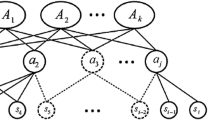Abstract
Activity recognition is an important component for the ambient assisted living systems, which perform home monitoring and assistance of elderly people or patients with risk factors. The paper presents a prototype system for activity recognition based on a multi-agent architecture. In the system, the context of the person is first detected using a domain ontology. Next, the human position is obtained and together with the context forms a sub-activity. The sequence of successive sub-activities is then assembled in a human activity, which is recognized using a stochastic grammar.
Access this chapter
Tax calculation will be finalised at checkout
Purchases are for personal use only
Preview
Unable to display preview. Download preview PDF.
Similar content being viewed by others

References
Eurostat (2010), http://epp.eurostat.ec.europa.eu/
Intille, S.S., Larson, K., Tapia, E.M., Beaudin, J.S., Kaushik, P., Nawyn, J., Rockinson, R.: Using a live-in laboratory for ubiquitous computing research. In: Fishkin, K.P., Schiele, B., Nixon, P., Quigley, A. (eds.) PERVASIVE 2006. LNCS, vol. 3968, pp. 349–365. Springer, Heidelberg (2006)
Ivanov, Y.A., Bobick, A.F.: Recognition of visual activities and interactions by stochastic parsing. IEEE Transactions on Pattern Analysis and Machine Intelligence 22(8), 852–872 (2000)
Iwaki, H., Srivastava, G., Kosaka, A., Park, J., Kah, A.: A novel evidence accumulation framework for robust multi-camera person detection. In: ACM/IEEE International Conference on Distributed Smart Cameras, pp. 117–124 (2008)
Joo, S., Chellappa, R.: Recognition of multi-object events using attribute grammars. In: IEEE International Conference on Image Processing, pp. 2897–2900 (2006)
Lymberopoulos, D., Barton-Sweeney, A., Savvides, A.: An easy-to-program sensor system for parsing out human activities. In: IEEE INFOCOM, pp. 900–908 (2009)
Mocanu, I.: From content-based image retrieval by shape to image annotation. Advances in Electrical and Computer Engineering (2010)
Mocanu, I., Kalisz, E., Negreanu, L.: Genetic algorithms viewed as anticipatory systems. In: AIP Conf. Proc., pp. 207–215 (2010)
Mocanu, S., Mocanu, I., Anton, S., Munteanu, C.: AmIHomCare: A complex ambient intelligent system for home medical assistance. In: Proceedings of the 10th International Conference on Applied Computer and Applied Computational Science, pp. 181–186 (2011)
Ryoo, M., Agarwal, J.: Recognition of composite human activities through context-free grammar based representation. In: IEEE Conference on Computer Vision and Pattern Recognition, pp. 1709–1718 (2006)
Turaga, P., Chellappa, R., Subrahmanian, V.S., Udrea, O.: Machine recognition of human activities: A survey. IEEE Transactions on Circuits and System for Video Technology 18(11), 1473–1488 (2008)
Vail, D.L., Veloso, M.M., Lafferty, J.D.: Conditional random fields for activity recognition. In: International Conference on Intelligent Robots and Systems, pp. 3379–3384 (2007)
Vogler, C., Metaxas, D.: A framework for recognizing the simultaneous aspects of american sigh language. Computer Vision and Image Understanding 81(3), 358–384 (2001)
Yamato, J., Ohaya, J., Ishii, K.: Recognizing human action in time-sequential images using hidden markov model. In: Computer Vision and Pattern Recognition, pp. 379–385 (1992)
Zeng, Z., Ji, Q.: Knowledge based activity recognition with dynamic bayesian network. In: Daniilidis, K., Maragos, P., Paragios, N. (eds.) ECCV 2010. LNCS, vol. 6316, pp. 532–546. Springer, Heidelberg (2010)
Zhang, D., Perez, D., McCowan, I.: Semi-supervised adapted HMMs for unusual event detection. In: Computer Vision and Pattern Recognition, pp. 611–618 (2005)
Author information
Authors and Affiliations
Editor information
Editors and Affiliations
Rights and permissions
Copyright information
© 2011 Springer-Verlag Berlin Heidelberg
About this paper
Cite this paper
Mocanu, I., Florea, A.M. (2011). A Multi-agent System for Human Activity Recognition in Smart Environments. In: Brazier, F.M.T., Nieuwenhuis, K., Pavlin, G., Warnier, M., Badica, C. (eds) Intelligent Distributed Computing V. Studies in Computational Intelligence, vol 382. Springer, Berlin, Heidelberg. https://doi.org/10.1007/978-3-642-24013-3_31
Download citation
DOI: https://doi.org/10.1007/978-3-642-24013-3_31
Publisher Name: Springer, Berlin, Heidelberg
Print ISBN: 978-3-642-24012-6
Online ISBN: 978-3-642-24013-3
eBook Packages: EngineeringEngineering (R0)



